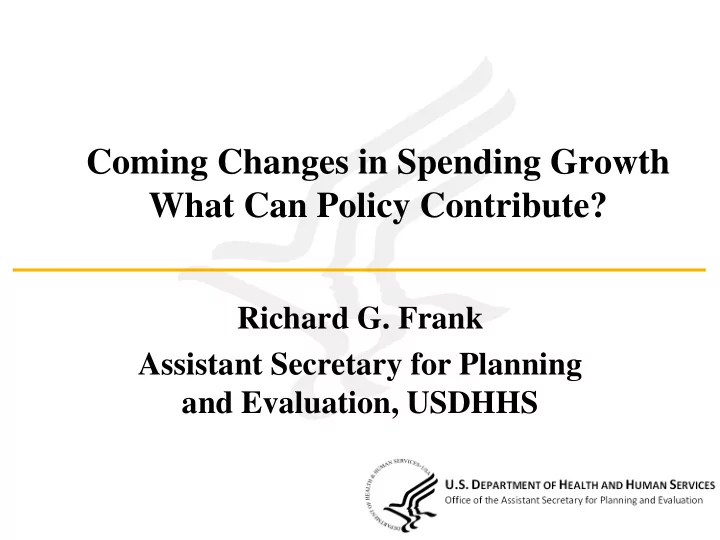

Coming Changes in Spending Growth What Can Policy Contribute? Richard G. Frank Assistant Secretary for Planning and Evaluation, USDHHS
Overview • What are the recent trends in spending growth? • How should we understand some recent upticks in spending? • What are the future prospects and what does policy have to do with it? • Use multiple data source across payer groups to provide a picture 2
Per Capita Growth, GDP and NHE 8% 6% Per Capita Growth 4% 2% GDP NHE 0% -2% -4% GDP and National Health Expenditures (NHE) shared similar growth rates between 2010 and 2013 3
Per Capita Growth, NHE and Medicare 10% Per Enrollee Spending Growth NHE 8% Total Medicare (OACT) 6% Medicare FFS (MBSF) 4% Note: 2014 Medicare FFS estimate based on claims data 2% 2014 and 2015 Total Medicare estimates based on Treasury Monthly Statements 0% -2% 2014 Uptick appears to be moderating 4
Service Category Growth, Medicare FFS 15% Inpatient Per Beneficiary Spending 10% Facility Outpatient (Hospital+ASC) Growth 5% Physician E&M 0% Part B Drug -5% Part D -10% PAC 5
Observations • Medicare spending experienced an uptick in growth in 2014 • One important factor was new products introduced into the market to treat Hepatitis C. That contributed to Part D increases (note differences in Parts B and D drugs) • Outpatient care spending grew more rapidly across service categories (MD, OPD) 6
Service Category Growth, Medicare FFS 15% Per Beneficiary Spending 10% Growth 5% Part D w/Hep C Specialty Drugs 0% Part D w/o Hep C Specialty Drugs -5% -10% After removing the contribution of specialty drugs used to treat Hepatitis C, the 2014 Part D spending growth rate declines substantially. 7
Per Capita Growth, NHE and Private Insurance 12% Per Enrollee Spending Growth 10% NHE 8% Private Insurance (OACT) 6% Private Insurance (MarketScan) 4% Private Insurance (S&P) 2% 0% -2% Following fairly steady growth 2010 to 2013,spending trended upward in 2014: Due largely to Rx spend and compositional change in individual market. Early 2015 data suggest a moderating of trend. 8
Service Category Growth, Private Insurance (S&P) 10% Per Enrollee Spending Growth 8% 6% Inpatient 4% Outpatient Professional 2% Drug 0% -2% Spending growth decreased for most service categories, but increased substantially for prescription drugs. 9
Per Capita/Enrollee Growth, NHE and Medicaid 8% Per Enrollee Spending Growth 6% NHE 4% Medicaid (OACT) 2% 2014 Actuarial Report Projection 0% -2% -4% Medicaid spending growth per enrollee has remained below 3% since 2008; due in part to compositional changes from expansion. 10
Observations • Outpatient spending has ticked up in Medicare but not for other payers – Hypothesis: policy emphasis in Medicare has been on inpatient care (value based purchasing, readmissions and hospital acquired conditions) all therefore serve to shift locus of care to outpatient settings • Prescription drug spending has grown notably across all payer classes including and excluding Hep C drugs 11
Estimated Effects of Specialty Drugs 2014 total US drug spending was $373.9B, up 13.1% * • • Growth driven by innovation, less expiry impact, and pricing dynamics • Spending on specialty medicines grew by 26.5% and reached one-third of medicine spending • Innovations in Hepatitis C, cancer, multiple sclerosis and diabetes drugs drove new spending • ASPE estimates that specialty drugs used to treat Hepatitis C accounted for approximately $3.8 B in Medicare FFS spending in 2014 • ASPE estimates the annual PCSK9 cost to Medicare to be $27 B (based on 2015 dollars), or 5% of total Medicare annual net outlays * IMS, 2015, A Review of the Use of Medicines in the U.S. in 2014 12
Looking Ahead • Payment reforms such as MSSP rules, bundling, Part C regulations, and MACRA along with private ACOs and exchanges expected to attenuate growth; payment rate reductions continue to impact overtime (productivity adjustment) • Continuation of trends in market such as larger deductibles and narrower networks may also blunt some spending growth (but less than claimed) • Spending growth on prescription drugs is likely to be lower than 2014 but will persist at levels above recent experience – The late stage of development pipeline is well populated with specialty drugs – Policy efforts aimed at increased competition could moderate trend somewhat (biosimilar regulations, pay for delay action, anti-trust) – Targeted negotiation could also help—political constraints are significant • Thus while spending growth may not remain at the low level of recent years we do not expect a return to anything like the pre-ACA rates 13
Recommend
More recommend